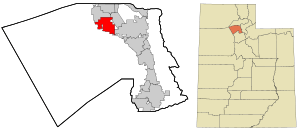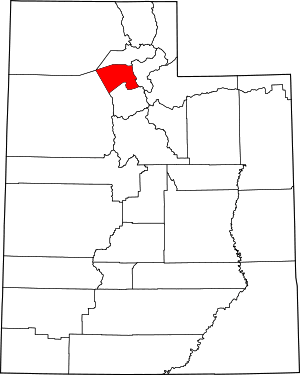Syracuse, Utah
Syracuse is a city in Davis County, Utah, United States. It is situated between the Great Salt Lake and Interstate 15, about 30 miles (48 km) north of Salt Lake City. It is part of the Ogden–Clearfield, Utah Metropolitan Statistical Area. The city has seen rapid growth and development since the 1990s. The city population was 24,331 at the time of the 2010 census,[2] an increase of 158.9% since the 2000 census.
Syracuse, Utah | |
|---|---|
 Syracuse City Municipal Center | |
| Motto(s): Provide quality affordable services while promoting community pride, fostering economic development and managing growth. | |
 Location in Davis County and the state of Utah | |
| Coordinates: 41°5′3″N 112°3′48″W | |
| Country | United States |
| State | Utah |
| County | Davis |
| Settled | 1878 |
| Incorporated | September 3, 1935 |
| City | September 13, 1950 |
| Named for | Syracuse, New York |
| Government | |
| • Type | Mayor-council government |
| • Mayor | Michael Gailey |
| Area | |
| • Total | 10.18 sq mi (26.37 km2) |
| • Land | 10.18 sq mi (26.35 km2) |
| • Water | 0.01 sq mi (0.02 km2) |
| Elevation | 4,285 ft (1,306 m) |
| Population | |
| • Total | 24,331 |
| • Estimate (2019)[3] | 31,458 |
| • Density | 3,091.39/sq mi (1,193.63/km2) |
| Time zone | UTC-7 (Mountain (MST)) |
| • Summer (DST) | UTC-6 (MDT) |
| ZIP code | 84075 |
| Area code(s) | 385, 801 |
| FIPS code | 49-74810 |
| GNIS feature ID | 1433147[4] |
| Website | www |
Syracuse was incorporated on September 3, 1935. The city was named by early settlers for Syracuse, New York, which was famed for its salt production in the 19th century.[5]
Geography
The city is located in northern Davis County on the eastern side of the Great Salt Lake. It is bordered to the north by West Point, to the northeast and east by Clearfield, and to the southeast by Layton. A causeway on SR 127 connects Syracuse to Antelope Island State Park in the Great Salt Lake.
According to the United States Census Bureau, Syracuse has a total area of 9.6 square miles (24.8 km2). Of which 0.01 square miles (0.015 km2), or 0.06%, are water.[2]
Demographics
| Historical population | |||
|---|---|---|---|
| Census | Pop. | %± | |
| 1890 | 299 | — | |
| 1900 | 299 | 0.0% | |
| 1910 | 553 | 84.9% | |
| 1920 | 629 | 13.7% | |
| 1930 | 890 | 41.5% | |
| 1940 | 732 | −17.8% | |
| 1950 | 837 | 14.3% | |
| 1960 | 1,061 | 26.8% | |
| 1970 | 1,843 | 73.7% | |
| 1980 | 3,702 | 100.9% | |
| 1990 | 4,658 | 25.8% | |
| 2000 | 9,398 | 101.8% | |
| 2010 | 24,331 | 158.9% | |
| Est. 2019 | 31,458 | [3] | 29.3% |
| U.S. Decennial Census[6] | |||
As of the census of 2010, there were 24,331 people, and 6,362 households residing in the city. The population density was 2,793.46 people per square mile (1,736.69/km²). There were 6,534 housing units at an average density of 298.6 per square mile (115.3/km²). The racial makeup of the city was 94.6% White, 2.9% Asian, 1.2% African American, 0.7% Native American, 0.6% Pacific Islander, 2.7% from other races. Hispanic or Latino of any race were 6% of the population.
There were 6,362 households out of which 42.0% (2010) had children under the age of 18 living with them, 83.3% (2000) were married couples living together, 5.4% (2000) had a female householder with no husband present, and 9.1% (2000) were non-families. 7.1% (2000) of all households were made up of individuals and 2.2% (2000) had someone living alone who was 65 years of age or older. The average household size was 3.81 (2010) and the average family size was 4.02 (2010).
In the city, the population was diverse with 42.0% (2010) under the age of 18, 10.6% (2000) from 18 to 24, 30.7% (2000) from 25 to 44, 14.9% (2000) from 45 to 64, and 4.5% (2010) who were 65 years of age or older. The median age was 26.5 years (2010). For every 100 females, there were 102.56 males (2010). For every 100 females age 18 and over, there were 101.4 males (2000).
The median income for a household in the city was $58,223 (2000), and the median income for a family was $60,000 (2000). Males had a median income of $41,346 (2000) versus $24,792 (2000) for females. The per capita income for the city was $16,989 (2000). About 2.1% (2000) of families and 2.4% (2000) of the population were below the poverty line, including 2.9% (2000) of those under age 18 and 6.5% (2000) of those age 65 or over.
Schools
- Syracuse Elementary
- Bluff Ridge Elementary
- Cook Elementary
- Buffalo Point Elementary
- Syracuse Arts Academy (elementary charter school)
- Syracuse Arts Academy Junior High (junior high counterpart to the elementary Arts Academy)
- Syracuse Jr. High School
- Syracuse High School
- Island View Residential Treatment Center
References
- "2019 U.S. Gazetteer Files". United States Census Bureau. Retrieved August 7, 2020.
- "Geographic Identifiers: 2010 Demographic Profile Data (G001): Syracuse city, Utah". American Factfinder. U.S. Census Bureau. Archived from the original on February 13, 2020. Retrieved January 11, 2016.
- "Population and Housing Unit Estimates". United States Census Bureau. May 24, 2020. Retrieved May 27, 2020.
- "US Board on Geographic Names". United States Geological Survey. 2007-10-25. Retrieved 2008-01-31.
- http://www.syracuseut.com/Community/DiscoverSyracuse/HistoryofSyracuse.aspx
- United States Census Bureau. "Census of Population and Housing". Retrieved June 2, 2014.
External links
| Wikimedia Commons has media related to Syracuse, Utah. |
- Official website
- Syracuse history, from the city website
- Local Syracuse, Utah Weather, live weather data provided by a personal weather station located in the Hansen Meadows subdivision.
